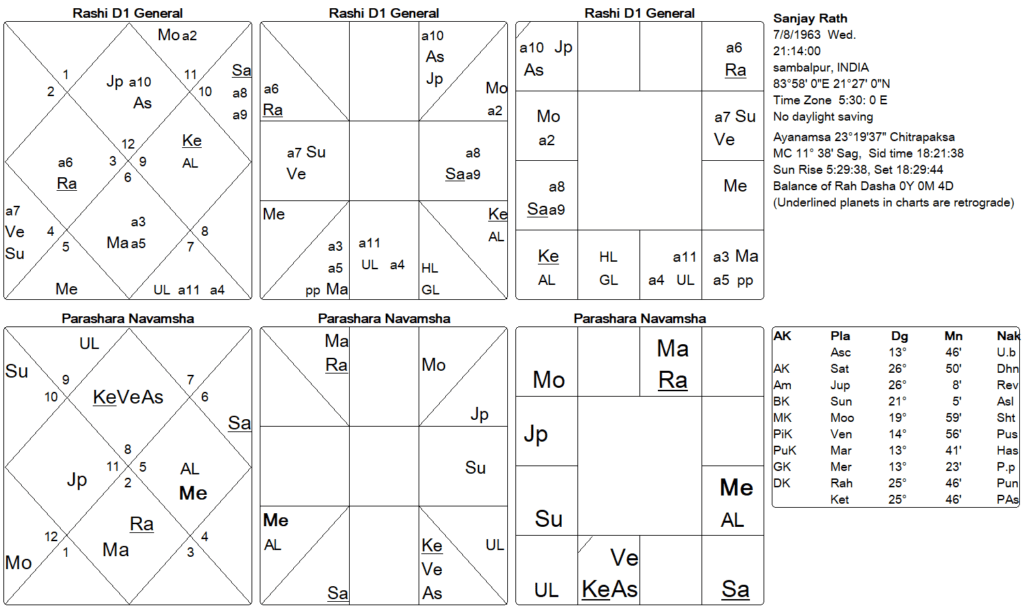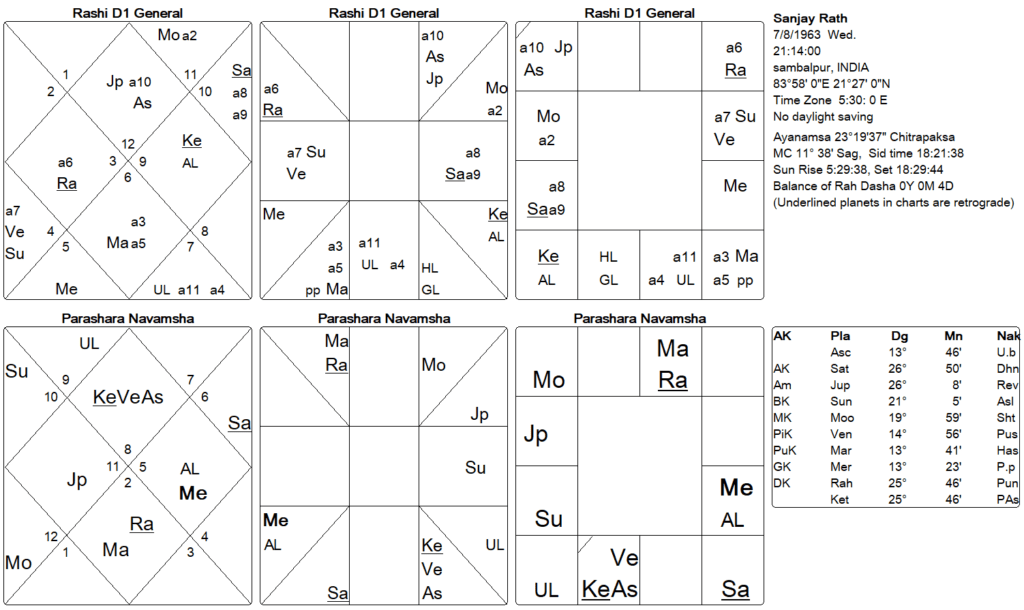Bhāva and Rāśi Sandhis
Sandhi or the transition zone between one bhāva and another and between two rāśis, is a problematic field of study in jyotish. It is a nebulous area where astrologers have so far failed to throw light on the reasons behind the peculiar nature of planets in sandhi and their effects on people’s lives. Being transitional in nature, sandhis are fuzzy and grey areas and planets placed in them are extremely fragile. They not only provide troublesome lives to their natives but continue to torment them throughout their lives by being unable to provide the results of their bhāvas or their rāśis. The asymmetrical juxtaposition of the rāśi and bhāva chakras complicates the situation further whereby bhāvas and rāśis overlap each other and planets caught in these points, affect both their rāśi and bhāva positions. Astrologers have tended to overlook this aspect entirely where planets in sandhi occupying different rāśis and bhāvas will not yield results of one or the other. It is therefore necessary to examine this phenomenon from closer quarters.
Bhāva Sandhi
There are two existing methods of defining bhāvas . One is the universally accepted method of Parāśara, and the other is the Śrīpati Paddhati. The Śrīpati Paddhati recognises the midheaven or the tenth house as a crucial point in a horoscope and one, which cannot be ignored. He therefore charts his path from the lagna to the 10th house, or from Prajāpati (the ruler of lagna) to Indra (the ruler of the 10th house), and divides the area into three parts. This comprises half the lagna, the 11th and the 12th houses and a half of the 10th house.
Parāśara’s position on the other hand begins with his object of worship, namely Sūrya and Brahmā. Sūrya the sun god, the source of all light, is but another name for jyotiṣa, or the light of god. Brahmā is the creator of this universe. Together, Brahmā and Sūrya represent Prajāpati or the lagna. To Parāśara, everything in the horoscope is based on the lagna, a point depicting the moment of creation. The horoscope is thus nothing but a map of the heavens at the time life began. Since the lagna is the entirety, it is but only natural that bhāva should be based on the lagna and the lagna lord. Bhāvas portray a person’s perceptions regarding his own life. The self or the created being (which is lagna), once created, begins to perceive and bhāvas represent his perceptions of the different aspects of his life, as characterised by separate houses. The Śrīpati Paddhati therefore fails here as it cannot be applied to the created being, but only for the devas like Indra.
A bhāva or a rāśi may be defined as nine navāmśas. Navāmśas are fixed and comprise one fourth of a nakṣatra. The last navāmśa of a bhāva which is 3° 20´ and the starting navāmśa of the next bhāva, which is again 3° 20´, comprise the areas delineated as bhāva sandhi.
Rāśi Sandhi
Lagna being a sensitive point, any planet placed in rāśi sandhi loses its power to do any good for its own house, and subsequently destroys the house. A planet in bhāva sandhi on the other hand, will only be concerned about saving its own house and not be bothered about its environment. Bhāva and rāśi sandhis therefore act in opposite ways while meting out their negative results. The lagnādhipati when placed in the lagna, usually gives a person name and fame, but if placed in bhāva sandhi, it will not do anything remarkable for him. Let us take the example of the native given below.
Chart 1 Male
The native in Chart 1 was born with an unrecorded but an approximate birth time. Upon his birth it was predicted that he would achieve great fame for himself. On this basis the placement of lagnādhipati Jupiter in Pisces lagna was ascertained outside the bhāva sandhi boundary. For a lagnādhipati placed in bhāva sandhi would not have made it possible for the native to have written several books and acquire a name for himself as he did internationally in astrology. The lagnādhipati in this case has not only protected the bhāva but being the lord of the lagna placed in its own house, reached the native to great heights of intellectual creativity and fame.
Chart 2 Female
 The above chart is an example of rāśi sandhi, whereby the planet placed in rāśi sandhi has destroyed its own houses. Mars, lord of 2nd and 9th houses is placed at rāśi sandhi at 0°0´ Taurus, the transitional point between the rāśis Aries and Taurus. As lord of the 2nd and 9th houses, it denied the native the fruits of these houses at a physical plane. As lord of the 2nd house, Mars at bhāva sandhi prevented the native from creating and sustaining a home and family till her middle ages. While as the lord of the 9th house it has denied her pitṛ sukha, as she lost her father when she was 21 years. This is a clear example of how a planet placed in rāśi sandhi destroys the houses it owns.
The above chart is an example of rāśi sandhi, whereby the planet placed in rāśi sandhi has destroyed its own houses. Mars, lord of 2nd and 9th houses is placed at rāśi sandhi at 0°0´ Taurus, the transitional point between the rāśis Aries and Taurus. As lord of the 2nd and 9th houses, it denied the native the fruits of these houses at a physical plane. As lord of the 2nd house, Mars at bhāva sandhi prevented the native from creating and sustaining a home and family till her middle ages. While as the lord of the 9th house it has denied her pitṛ sukha, as she lost her father when she was 21 years. This is a clear example of how a planet placed in rāśi sandhi destroys the houses it owns.
The worst forms of rāśi sandhis are known as gandāntas. Parāśara has identified three gandāntas, namely, Pisces-Aries, Cancer-Leo and Scorpio-Sagittarius overlapping their nakṣatra gandāntas at Revatī-Aświnī, Aśleṣa-Maghā and Jyeṣṭhā-Mūla. Of these he considers the Jyeṣṭhā-Mūla gandānta to be the worst afflicted and the Revatī- Aświnī to be the least problematic. The deity of the nakṣatra lord is to be propitiated for the solution to this predicament.
One must note that a planet placed in rāśi sandhi may or may not occupy the same bhāva. If the planet is in rāśi sandhi and in the same bhāva, it will give the result of the bhāva rather than the rāśi. If it is placed in a different bhāva, the results of the ownership of the house will prevail. In the case there are too many planets in one rāśi, the native will be confused as to what he truly desires. In this instance the placement of the lords of the bhāvas in the different houses becomes very important.
1 comments
Reply


Hello. this is not the case map for the second example